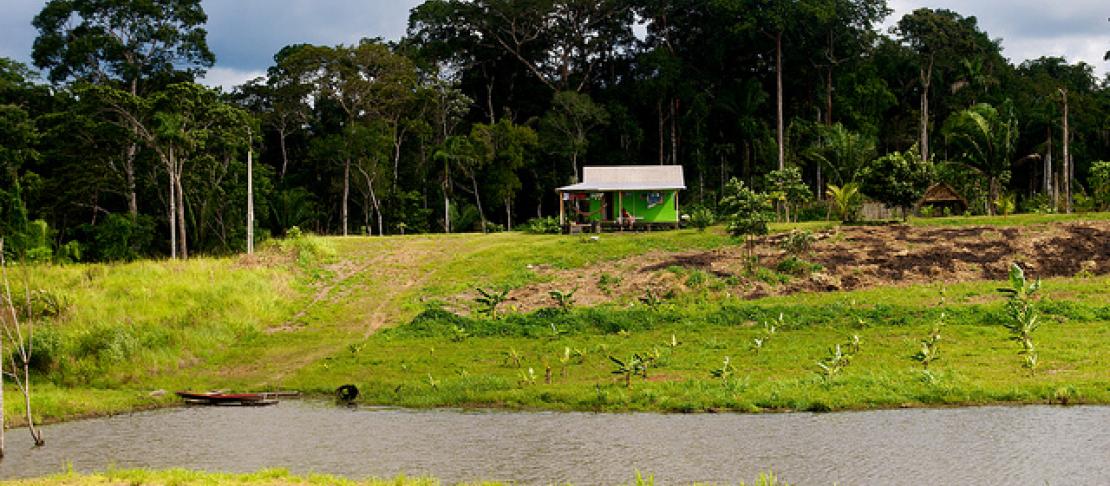What have we learned about governing agricultural and forest areas to achieve climate change mitigation?

Researchers examine 12 types of agriculture-forest governance interventions in the tropics and their outcomes for conserving forest in a special section of Global Environmental Change.
Stopping deforestation due to agriculture is difficult, especially with pressures to increase food and commodity production. We now understand that intensifying agriculture reduces the amount of total land needed at a global level. But at local levels, agriculture will often expand if it is economic to do so and not otherwise prevented. Hence the need for governing agriculture-forest areas arises in a way that tackles climate change mitigation.
To see how improved governance has helped to protect forests in the past, Arun Agrawal, Eva Wollenberg and Lauren Persha conducted a major review of the empirical evidence on this subject, including a meta analysis and the commissioning of papers. Their analysis and four papers have just been published in a special section of Global Environmental Change, titled “Governing Agriculture-Forest Landscapes to Achieve Climate Change Mitigation.”
The special section looks at 12 types of agriculture-forest governance interventions in the tropics and their outcomes for conserving forest (assumed to be a high carbon landscape). In the introduction to the special section, Agrawal et al. review the interventions in terms of three dimensions--rights and institutions that reflect social agreements; incentives and rewards; and technologies—and summarize the characteristics of the interventions and their relationship to deforestation. To test for statistically significant patterns, they also conducted a meta-analysis of 123 cases. They find smaller-scale interventions and more effective enforcement to be associated with more positive forest outcomes. No other strong pattern emerged, leading to several key conclusions about generalizability of findings from existing research on agriculture-forest landscapes.
The four other articles in the special section review major interventions in more depth:
- Meta-analysis of relationship between tenure and tropical deforestation by Brian Robinson, Margaret Holland and Lisa Naughton-Treves
- Reward-based incentives vs. regulation and sanctions in Brazil by Jan Börner, Sven Wunder, Sheila Wertz-Kanounnikoff, Glenn Hyman and Nathalia Nascimento
- Agricultural investment and intensification of rubber in Southeast Asia by Jefferson Fox, Jean-Christophe Castella and Alan Ziegler
- Land decentralized, multi-stakeholder participation in land use decisions in Australia by Penny van Oosterzee, Allan Dale and Noel Preece
From this rich set of empirical experience, some observations emerge:
- Tenure security, accompanied by supporting social and legal institutions, matters more than the form tenure takes.
- Enforcement seems to be consistently associated with positive forest outcomes and (in the Brazilian context) is predicted to cost less than environmental payments.
- Land use categories should be assessed for their actual carbon sequestration and not based on assumptions related to categories of agricultural or forest land use.
But trying to identify the average effects of any intervention in forest-agriculture may conceal as much as it reveals. Such an approach treats interventions, their implementation and their effects as if they are roughly similar and can be disentangled from the context of the intervention or its implementation.
It is self-evident that a protected area differs from a payment for environmental services scheme or from agricultural intensification, even if all three aim to reduce deforestation. But, additionally, any one protected area differs from other protected areas. Any one payment scheme differs from other payment schemes. And a given intensification project differs from others... Assumptions about how we analyze these interventions and how they work need to be examined anew." - Lead author Arun Agrawal
Implications for the design and evaluation of policy
The effects of interventions are difficult to predict from their form alone. It is necessary to understand how interventions function in specific contexts. For example, experience with decentralization show that decentralization can have positive or negative effects on forests depending on how reforms are pursued and the countervailing political and economic interests working against them. Meaningful participation, guarantees of decision making on key issues, institutionalized accountability mechanisms and sufficient resources support effective decentralization. Equally important, however, is understanding how these opportunities measure against the influence of powerful-centralizing forces, such as national government offices, the military, donors or large corporate interests that may actively work against local interests. Designs of decentralization often neglect one or more of these pillars of decentralization, pursuing form at the expense of function.
Bluntness and variability of governance instruments, interactions with political, social and economic contextual factors, variations in implementation and multiple types of deforestation pressures mean that interventions are seldom tightly coupled with specific outcomes. The meta-analysis and articles in the special section demonstrate that interventions to manage agricultural-forest landscapes tend to be only loosely coupled to desired outcomes, making predictions about impacts of future interventions and improvements in their design difficult. This makes outcomes difficult to attribute to interventions precisely or reliably over time. Policy sciences in this arena thus requires better theory, more systems-oriented analyses, and adaptive learning.
The relative effectiveness of interventions is difficult to generalize. The 12 intervention types reviewed have been used in different spatial and social contexts to counter deforestation pressures. Their effectiveness depends not only on their content, but what they have added to an existing set of policy, economic and technical conditions. Interventions also generate other outcomes, affecting livelihoods, biodiversity, participatory processes and the like. Additionally, few policy interventions are so precise as to produce only a single intended effect. Clearly far more information is needed in any one context about how deforestation-related interventions function and their effectiveness in agriculture-forest landscapes.
Understanding how interventions work to achieve mitigation in agriculture-forest landscapes will require closer attention to how the implemented intervention functions in a given context. Generalizing policy effects may be possible for simple contexts, but given the complexity of forest-agriculture interactions and influences, more careful case-by-case analyses and understanding and adaptive management are necessary.
access the papers
Governing agriculture-forest landscapes to achieve climate change mitigation by Arun Agrawal, Eva Wollenberg, Lauren Persha |
| Meta-analysis of relationship between tenure and tropical deforestation by Brian Robinson, Margaret Holland and Lisa Naughton-Treves |
| Reward-based incentives vs. regulation and sanctions in Brazil by Jan Börner, Sven Wunder, Sheila Wertz-Kanounnikoff, Glenn Hyman and Nathalia Nascimento |
Agricultural investment and intensification of rubber in Southeast Asia by Jefferson Fox, Jean-Christophe Castella and Alan Ziegler |
| Land decentralized, multi-stakeholder participation in land use decisions in Australia by Penny van Oosterzee, Allan Dale and Noel Preece |
Lini Wollenberg leads research on Low-Emissions Agricultural Development for the CGIAR Research Program on Climate Change, Agriculture and Food Security (CCAFS). She is based at the Gund Institute, University of Vermont.



